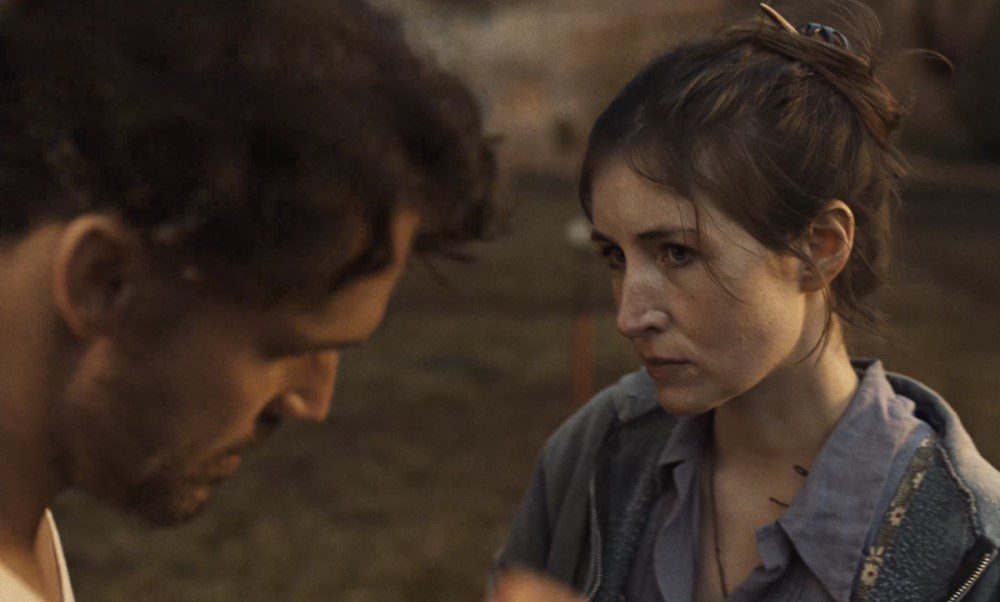I am an avid lover of animated science fiction. If you want a conversation with me to stumble into a rambling geek-love rant, mention Futurama, Akira, Serial Experiments Lain, or any number of other films or television shows out there. In late November, I stumbled across a post on Instagram showing off the beauty of the recent Max series Scavenger’s Reign. The post didn’t delve into anything to do plot-wise with the show but showcased the incredible artistry and depth in Scavenger’s Reign’s breathtaking landscapes. I have a love/hate relationship with Max at the moment. I love the content, but I wouldn’t say I like the price. I may also harbor some negative feelings toward Max’s overseer, Warner Brothers’ CEO David Zaslav, too. Lucky for me, Max was on sale for three smackers during Black Friday. Sure, it may have ads, but it’s worth it for me versus the cost gap in going adless, especially during the holiday season. If it hadn’t been for the reel of the show, I wouldn’t have signed back up. Hell, I wouldn’t have even known the show existed.
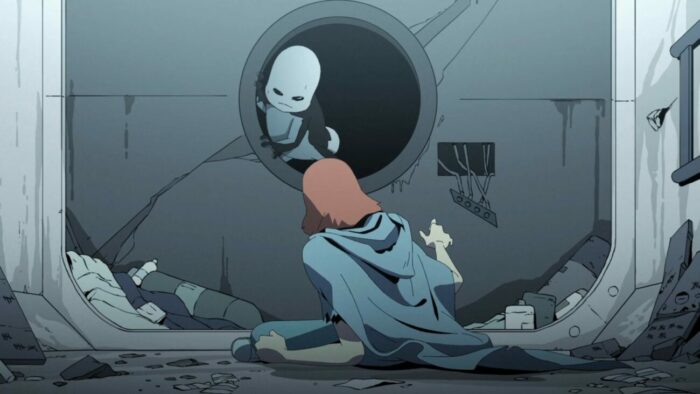
It took less than fifteen minutes to get me hooked on Scavenger’s Reign, binging it all in two sittings.
If there are any René Laloux fans out there, specifically lovers of Fantastic Planet, you will fall head over heels for the world that creators Joe Bennett and Charles Huettner have manifested. It’s a rich, vibrant visual feast of a planet dazzlingly animated to leave you in awe as its characters face constant peril through every step of their journeys. The show takes place on a foreign world where the survivors of a transport ship, the Demeter 277, have crashed landed. Separated from each other, the audience is left unsure about how long it has been since whatever left them stranded on the planet has happened, though it’s abundantly clear they have been here long enough to understand how hostile the planet’s flora and fauna are, while the audience quickly learns how deadly even the most beautiful of the planet’s elements can be.
None of the groups have any contact with one another, causing a trio of survival tales to unfold. Sam (Bob Stephenson), the ship’s captain, and Ursula (Sunita Mani), a horticulturist, spend much of the series’ first episode looking for a working battery to signal the Demeter to perform an emergency landing on the planet. Once successful, the ship acts as a beacon to Azi (Wunmi Mosaku) and her robot Levi (Alia Shawkat), setting all four individuals on split adventures across the dangerous terrain and back to the ship they once called home. The final individual we follow is Kamen (Ted Travelstead), who encounters a telepathic creature called Hollow, which manipulates Kamen into providing sustenance for it at a high consumption rate and ardent ease. Hollow and Kamen eventually journey toward the Demeter as well, but their storyline is far different from any other relationships in the show.
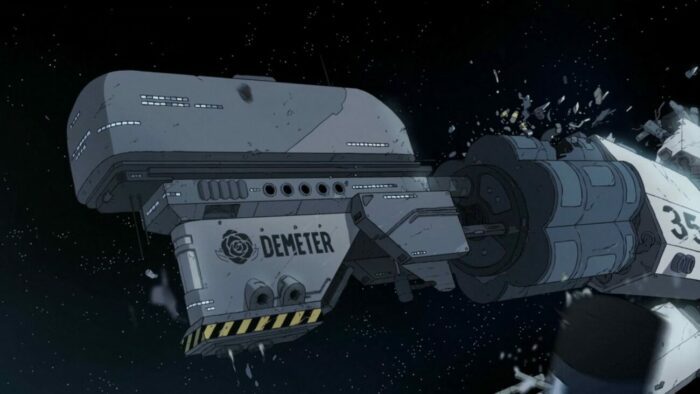
Hollow initially appears as a neutral creature, perhaps even a visually sympathetic and slightly adorable organism. I honestly saw a lot of inspiration drawn from Spirited Away’s No-Face throughout the show, and I think others will make some similar comparisons. Like No-Face, Hollow radiates natural curiosity and finds a similar obsession with Kamen as No-Face found with Chihiro. While No-Face’s emotions seem to come from those he consumes, Hollow’s comes from his telepathic link to Kamen. Moreover, once connected with Kamen, the creature begins to elicit human emotions stemming from Kamen’s avarice for feeling he deserves more out of life. When Hollow understands Kamen’s desire to return to the downed ship, Hollow feels the bond of the telepathic symbiosis is threatened and decides to eradicate anything that will take Kamen away from the creature.
Hollow isn’t inherently evil, which leads to the point of Scavenger’s Reign. After saving Kamen from near death, the creature burrows itself inside his mind, becoming exposed to the scenarios that torment Kamen’s soul. While Hollow is the only one with telekinetic abilities, the bond affects both entangled in the symbiosis. Hollow, having the emotional intelligence of a child, begins relating to Kamen as if his perspective is the only one that matters. Kamen’s narcissism and ego are shown through flashbacks to a more objective audience, while Hollow empathically connects with Kamen through his self-centered choices. Throughout the series, Hollow drives Kamen to do things he doesn’t want to do, as the creature attests to its self-serving nature. Yet, Hollow continues caring for Kamen when his mental health begins to suffer, and Hollow’s aggressive manipulation causes Kamen to break down. As they journey to the ship, Hollow becomes a villain to the others by aligning any choices with Kamen’s selfish transgressions. The show begins to take on a deeper context, discernibly in how we view nature, our humanity, and its survival.
As I stated earlier, the audience remains unsure of the exact length of time the crew has spent on the planet, particularly given Kamen’s isolation in the remnants of a shuttle. Still, it becomes apparent that everyone else has been on the surface long enough to understand the planet’s continuous threats. In episode two, the crew must find shelter to protect themselves from a storm producing 200 mph winds and dropping sharp shards of glass-like rain. Each finds themselves as equally reliant on the planet for survival as they find themselves threatened by it. Sam and Ursula stumble upon a turtle-like creature with an ovipositor neck and no head, scooping its eggs up off the beach and retaining them inside its body. The hard-shelled creature carries its unhatched babies out to sea, and Sam and Ursula decide to use the creature as a resource. Safety not guaranteed, the two don’t stay safe for long. These creatures are visited by invasive insectoids that feed on the eggs for sustenance, placing the pair in a visually apparent bottle situation.
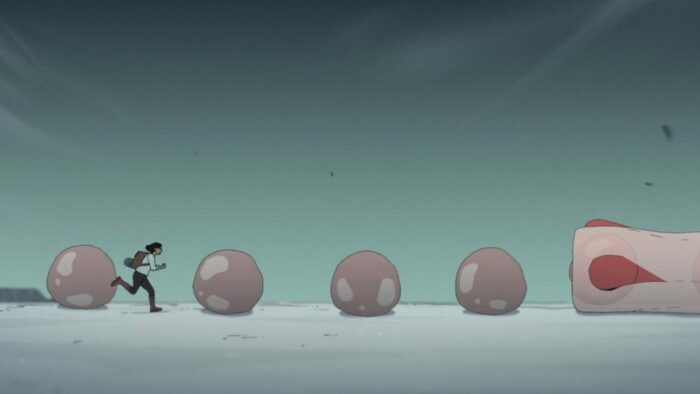
Azi and Levi are forced to leave their escape pod shelter and hold up in the center of a free-growing rock-bamboo formation containing an independent biome. The flourishing environment inside offers a complete spectrum shift to the wasteland the duo faced outside. It’s here where Levi notices a change in her robot companion. Levi knew enough to come to the structure and where to crawl inside but had hidden the fact they had been exploring the area while Levi slept. Scavenger’s Reign takes the viewer on a new journey, discussing the risks and merits of naturally evolving AI. Azi soon learns that a lichen-like build-up inside Levi is causing them to feel and develop thought processes similar to that of a human child. Distracted by the stunning beauty in the world around them, Levi’s childlike curiosity threatens Azi’s safety, leaving her hesitant to trust her newly sentient companion. The Azi and Levi storyline only gets better from here on out, doling out exciting and poignant moments as they trek across the planet to the Demeter.
The name Demeter isn’t a coincidence, either. While most will quickly note a reference to Bram Stoker’s novel Dracula in their namesake shipwreck similarities, there’s more inference in the Demeter’s mythological meaning. The Greek goddess Demeter, daughter to Cronus and Rhea and mother to Persephone, is the goddess of the harvest and agriculture. The name serves as a symbol for this duality, both the beauty and horror of nature. At first glance, you may see a veritable Eden, but with the arrival of Scavenger’s Reign’s Demeter, filled with people in cryo-chambers traveling like the vampire of Bram Stoker’s novel, nature becomes threatened, unsettling the harmony of paradise.
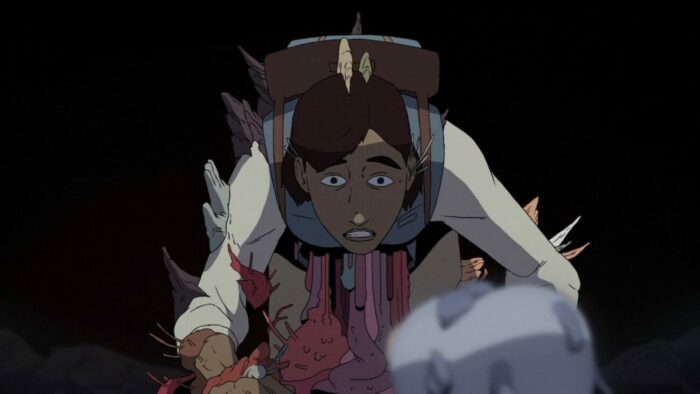
Azi and Levi’s story in episode two, “The Storm,” also adds a philosophical element to the story that conceptually ponders humanity in the sustainability equation. Levi, being compelled by environmental forces, plants seeds to grow a fruit-bearing tree that’s deadly to humans. When asked why, Levi doesn’t know, but the frame changes to show the benefit the act had on the biome. Though Azi’s survival depends on Levi making decisions to protect her, Levi does something selfless as if her internal system corruption is also symbiotic and reliant on Levi’s aid as well. While much of the show is derived from the unwavering persistence of the human spirit, Scavenger’s Reign often provokes esoteric ideas about human existence and its extinction. Levi considers the whole of the planet, acting like a scion for the future, born of man and evolved by nature, helping viewers contemplate if AI could be man’s natural evolution and what steps it will take to protect the planet it resides on that has made all life possible.
And that leaves the last two adventures of Scavenger’s Reign, Sam and Ursula. During their journey, a parasite is introduced into Sam’s bloodstream. While it helps him recuperate from a fatal disease, it also obliges him to force a parasite into Ursula, among other uncharacteristic urges. Like Azi’s wariness to Levi’s changes, Ursula finds Sam challenging to trust. Like Kamen’s situation, Sam’s dependence on this parasite jeopardizes his mind.
All three of these stories form a kind of cyclical diagram where outcomes vary, but the stories are so brilliantly unique in how humans respond to their situations. Scavenger’s Reign doesn’t shy away from struggles of depression and futility, nor does it grandstand when its characters triumph. Nature is shown to be impartial, necessary, and dangerous. Balanced. The conclusion of our character’s journeys begs us to ask if humans are helping or hurting our environment. Are we symbiotic with nature or parasiticly harming it?
At the start of this article, I mentioned my contempt for David Zaslav. Fans of animated programming probably already know where I’m going with this, as he’s the reason multiple science fiction and animated projects have been removed from the Max service, with some, such as Olan Rogers’ Final Space, being lost to the digital ether. There are also those discriminately shelved Warner Brothers films, such as the highly publicized Coyote vs. Acme, and those tossed from their streaming homes like Westworld and Raised by Wolves. I have to say I was stunned to see such a magnificent, high-caliber animated science-fiction show debut on Max during Zaslav’s tenure. I was less surprised that Scavenger’s Reign wasn’t being made into a much bigger deal.
Scavenger’s Reign may end up only being a mini-series thanks to Zaslav’s predisposition to the medium despite a hopeful update from its creators speaking with Comicbook, saying they’ve “mapped out” a “couple more seasons.” They’re still waiting for the green light. Nevertheless, the show is spectacularly cinematic and is possibly the best science-fiction series to emerge from 2023. I binged it in two sittings, thoroughly immersed in the colors and scale of the animators’ artistic vision and swept up in the plight of the Demeter crew’s stories. I implore science fiction and anime fans to check this one out. You won’t be disappointed.
Scavengers Reign | Official Trailer | Max
Their time is short. #ScavengersReign premieres on Oct 19th. About Max: Max is the culture-defining entertainment service for every mood. With a variety of genres that include your favorite series and movies from iconic brands and treasured franchises, it delivers irresistible stories every time.



